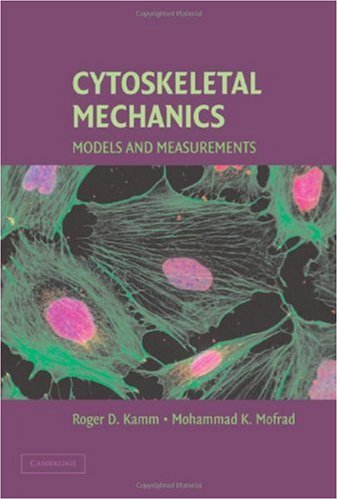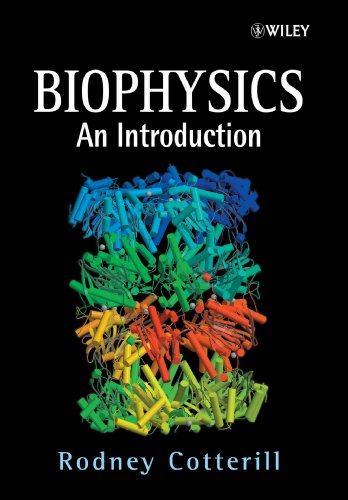Mohammad R. K. Mofrad, Roger Kamm0521846374, 9780521846370, 9780511250385
Table of contents :
Cover……Page 1
Half-title……Page 3
Title……Page 5
Copyright……Page 6
Contents……Page 7
Contributors……Page 9
Preface……Page 11
Introduction……Page 13
Maintenance of cell shape……Page 14
Cell migration……Page 16
Mechanosensing……Page 17
Stress responses and the role of mechanical forces in disease……Page 18
Structural anatomy of a cell……Page 19
Transmission of force to the cytoskeleton and the role of the lipid bilayer……Page 21
Intracellular structures……Page 22
References……Page 27
Introduction……Page 30
Methods to measure intracellular rheology by macrorheology, diffusion, and sedimentation……Page 31
Sedimentation of particles……Page 32
Diffusion……Page 33
Cell poker……Page 34
Atomic force microscopy……Page 37
Mechanical tension applied to the cell membrane……Page 38
Fluid flow……Page 40
Optical traps……Page 42
Magnetic methods……Page 44
Pulling by magnetic field gradients……Page 46
Twisting of magnetized particles on the cell surface and interior……Page 47
Passive microrheology……Page 48
One-particle method……Page 49
Two-particle methods……Page 50
Dynamic light scattering and diffusing wave spectroscopy……Page 51
Fluorescence correlation spectroscopy……Page 53
Acoustic microscopy……Page 54
References……Page 55
Introduction……Page 62
Magnetic Twisting Cytometry (MTC)……Page 63
Measurements of cell mechanics……Page 64
Frequency dependence of g’ and g”……Page 66
The structural damping equation……Page 67
Reduction of variables……Page 68
Universality……Page 70
Scaling the data……Page 71
Collapse onto master curves……Page 72
What are soft glassy materials……Page 74
Sollich’s theory of SGMs……Page 75
Open questions……Page 76
Malleability of airway smooth muscle……Page 77
References……Page 80
Introduction……Page 83
Purpose of continuum models……Page 84
Principles of continuum models……Page 87
Mechanical and material characteristics……Page 88
Blood cells: leukocytes and erythrocytes……Page 90
Adherent cells: fibrobasts, epithelial cells, and endothelial cells……Page 91
Conclusion……Page 93
References……Page 94
Introduction……Page 96
Biphasic (solid–fluid) models of cell mechanics……Page 97
Biphasic poroviscoelastic models of cell mechanics……Page 99
Multiphasic and triphasic models (solid–fluid–ion)……Page 100
Analysis of cell mechanical tests……Page 101
Cells……Page 102
Biphasic properties of the pericellular matrix……Page 104
Indentation studies of cell multiphasic properties……Page 106
Analysis of cell–matrix interactions using multiphasic models……Page 108
Summary……Page 110
References……Page 111
Introduction……Page 115
The cellular tensegrity model……Page 116
Definitions, basic mechanisms, and properties of tensegrity structures……Page 117
The cellular tensegrity model……Page 118
Circumstantial evidence……Page 119
Prestress-induced stiffening……Page 121
Action at a distance……Page 122
Do microtubules carry compression?……Page 124
The role of intermediate filaments……Page 125
Examples of mathematical models of the cytoskeleton based on tensegrity……Page 126
The cortical membrane model……Page 127
Tensed cable nets……Page 128
Cable-and-strut model……Page 130
Tensegrity and cellular dynamics……Page 133
Conclusion……Page 136
References……Page 137
Introduction……Page 141
Problems with the aqueous-solution-based paradigm……Page 142
Cells as gels……Page 144
Cell dynamics……Page 147
Gels and motion……Page 150
Secretion……Page 151
Muscle contraction……Page 152
References……Page 159
Introduction……Page 164
Single-filament properties……Page 166
The worm-like chain model……Page 167
Force-extension of single chains……Page 168
Dynamics of single chains……Page 172
Solutions of semiflexible polymer……Page 174
Network elasticity……Page 175
Nonlinear response……Page 177
Discussion……Page 179
References……Page 180
Introduction: The role of actin in the cell……Page 182
Interaction of the cell cytoskeleton with the outside environment……Page 184
Properties of actin filaments……Page 186
The role of filamin A (FLNa)……Page 187
The role of cytoskeletal structure……Page 188
Actin mechanics……Page 189
The emergence of actin dynamics……Page 192
The intrinsic dynamics of actin……Page 193
ADF/cofilin: targeting the rate-limiting step in the actin cycle……Page 195
Arp2/3 complex and formins: making filaments anew……Page 197
Gelsolin: rapid remodeling in one or two steps……Page 199
Dynamic actin in crawling cells……Page 200
Actin in the leading edge……Page 201
Monomer recycling: the other ‘actin dynamics’……Page 203
The biophysics of actin-based pushing……Page 205
Conclusion……Page 207
References……Page 208
Cellular protrusion: the standard cartoon……Page 216
The RIF formalism……Page 217
Mass conservation……Page 218
Momentum conservation……Page 219
Boundary conditions……Page 220
Cytoskeletal theories of cellular protrusion……Page 221
Network–membrane interactions……Page 222
Network dynamics near the membrane……Page 224
Network–network interactions……Page 225
Other theories of protrusion……Page 227
Numerical implementation of the RIF formalism……Page 229
An example of cellular protrusion……Page 230
Protrusion driven by membrane–cytoskeleton repulsion……Page 231
Protrusion driven by cytoskeletal swelling……Page 232
Discussion……Page 233
Conclusions……Page 234
References……Page 235
11 Summary……Page 237
References……Page 241
Index……Page 243







Reviews
There are no reviews yet.